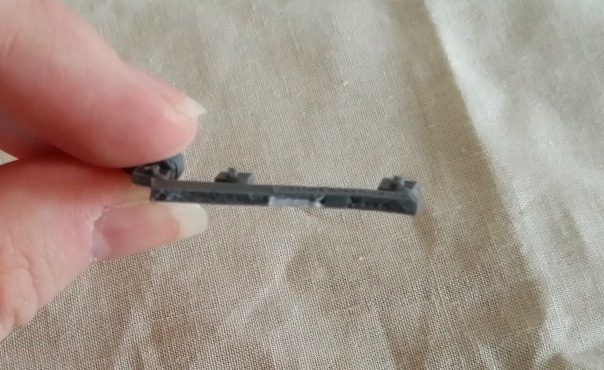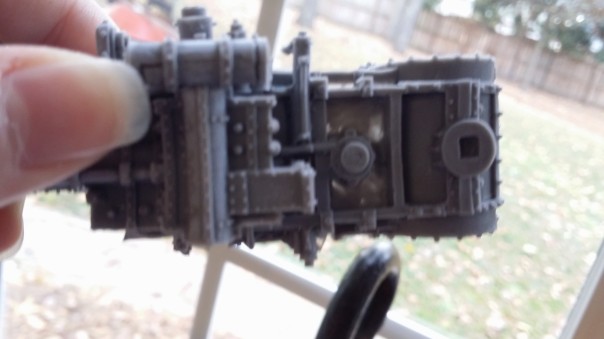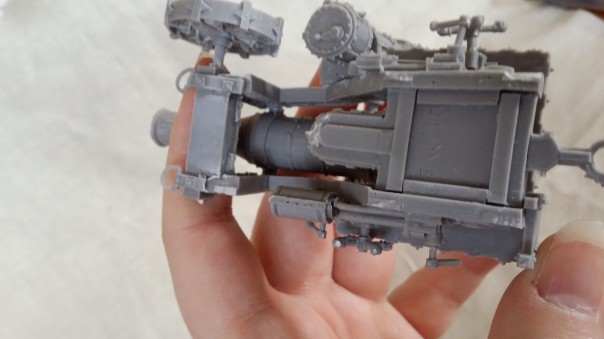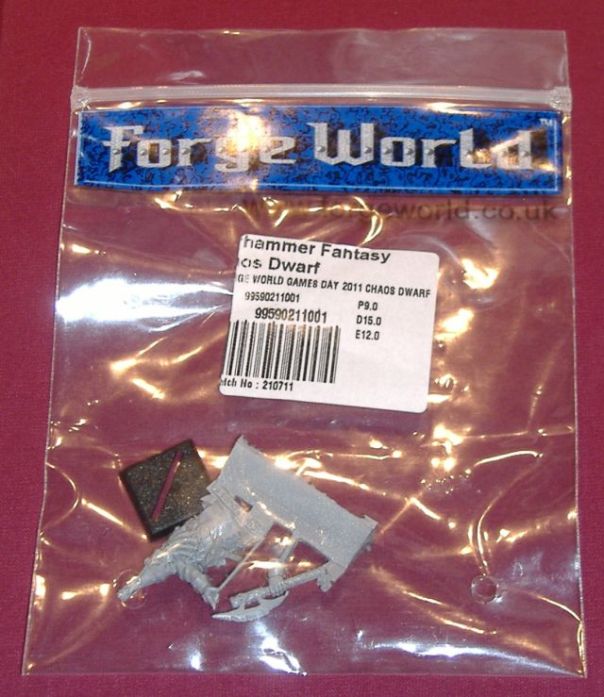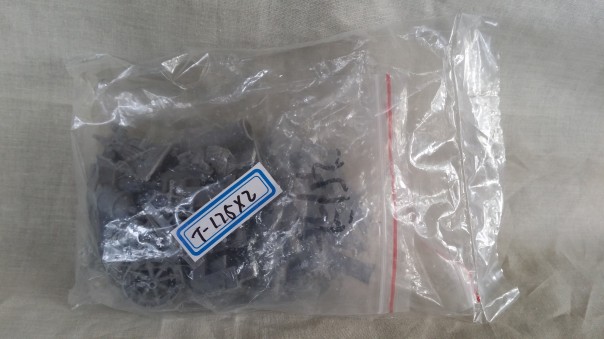Category Archives: Forge World
WIP: Chaos Dwarfs
This month I am beginning a Chaos Dwarf army commission. The first unit is 15 Scibor Moscal Strielecs, a Scibor Moscal standard bearer, Scibor Moscal musician, Scibor Moscal officer, Scibor Moscal cannon crew (3 dwarfs), and GW IG Cadian heavy weapons team mortar – representing 24 Chaos Dwarf Infernal Guard with Blunderbusses. I’m starting with the Scibor Moscal Strielecs.
The cleanup on the Strielecs so far was fairly annoying. Although the resin seems nice enough, the models were plagued with bubbles. There were a few areas of weird textures, and part of the gun barrel was missing on many models. There were very few mould lines, however, and they were very fine if the model even had any.
The models are nicely sculpted with lots of details, but (and this is just my personal pet-peeve) the delineation between areas on the model isn’t sharp enough. For instance, faces almost blend right into coats. To me, this makes painting far more difficult.
I primed the first 6 Strielecs.
Upcoming projects!
It appears that there is an entire Chaos Dwarf army in my future, as well as a Be’lakor Daemon Prince (with a daemon throne base I’m really excited about), and a Legion of Everblight starter set. What a great way to start painting in 2014!
I do still have room in my schedule to fit in some commission work. Contact me if you are interested!
How to tell recast Forge World miniatures
There are a ton of recast miniatures in circulation, and it seems that most people cannot tell the difference. There just isn’t a lot of information out there about how to tell the difference, so I thought it would be a good idea for me to post about a few things to look for if you suspect you may be dealing with recasts.
1. When purchasing new models on eBay, the models come from Russia or China. Although there certainly can be legitimate Forge World models currently located in these places that the current owner wants to liquidate, most of the time those will be used. These countries have different laws regarding intellectual property, copyright, and counterfeiting, so Forge Word/Games Workshop has been unable to shut these re-casters down.
2. The way the models attach to the sprue could be a clue. As an example, Forge World Chaos Dwarfs come on large triangle sprues.
Here is a recast that appears that the original Forge World model used to make the mould was cut from the large triangle on the bottom of the sprue. This made the mould have a rough bottom from the cuts. They put a gate on the middle of the original sprue, and then the recast model was cut there causing the white area in the middle.
3. Thin casts is another sign of a re-cast model. This can often be seen in flat areas, faces, arms, and legs.
Here you can see through the wings of the model, and the cast is actually so thin that there are holes beyond what there should be
Although not pictured, the face of the rider on that model had extra thin features. His nose was just a thin line of resin, and his cheeks were malformed.
Here is another example of a thin cast. The shoulders and necks are so thin they have holes in them. This model is actually supposed to have symbols on the inside of the shoulders, but the cast is too thin to preserve them.
Here is a warmachine that is too thin on the bottom.
4. Miscasts beyond the norm are another indicator that the model is a forgery. On this model there is a weird texture on the bottom. You may find weird textures like this on the bottom, inside, etc.
Here is a model missing some details, and other details are much softer than they should be.
This bit has areas where the resin filled what should have been open space. This type of miscast is common on recasts.
This bit has a similar issue.
5. Double mold lines are also a giveaway for counterfeit models. One mould line would be part of the mould from the original, and the other mould line would be from the casting process. They can be next to each other or perpendicular from each other or at other angles, but any particular part of the model should have one mould line running around it, not two.
6. Peculiar packaging is another sign.
Here is true Forge World packaging.
And here is the packaging of one particular set of “Forge World” recasts. Notice how there are ziploc bags inside the mostly unmarked manufacturer sealed bag and a stick on label with writing on it instead of the brand labeling.
Ultimately, the only way for sure to tell if a model is truly Forge World or a recast is for Forge World to test the model. These signs are clues that there may be a problem. Please remember that it is illegal to even possess counterfeit (recast) models. It is illegal to recast for financial gain, as well as for your own personal use. It is illegal to sell or trade them. This violates intellectual property and copyright law. If you suspect you have counterfeit models, you should contact Forge World/Games Workshop legal. They will probably request pictures and contact info for whoever sold or traded them to you. If you have unknowingly purchased counterfeit models on eBay or through PayPal, they may be able to help you with a case against the seller. They may also ask you to send them the models to be tested.
Upcoming Post: How to tell Forge World recasts from the real thing
Recently someone I know bought what he believed were Forge World Chaos Dwarfs. They were second hand, and he had no reason to believe they were anything other than what the seller claimed they were. As used models they were a little worse for the wear, but still a great deal overall.
Unfortunately, the models turned out to be counterfeit. Now he is having to deal with a PayPal claim and the legal department at Forge World to get this resolved. Selling counterfeit goods, even unknowingly, is a violation of patent, copyright, and trademark laws. There seems to be a lot of Forge World recasting going on out there (especially on eBay), and not a lot of information available about how to spot it.
In the next week or so I plan to post about some of the ways to spot a fake Forge World model and how we determined these in particular were fake (aside from the confirmation from Forge World!).
Kickstarter: Reaper Bones II & WIP update
As the final day of the Reaper Bones II Kickstarter went on it got better and better until…
I can’t wait to paint that thing! Too bad it’ll be a year before it arrives!
On another note, the Ogre army I was painting Maneaters and the Giant Spined Chaos Beast for was at Grail Quest this weekend. Tomorrow I should be able to put up final pictures of the models I painted.
Next I’m painting a Reaper mini to be used in a D&D game and a Convergence of Cyriss Mitigator for Project Orange Crush: Hunger, so expect WIP pictures soon!
Tutorial: Forge World Giant Spined Chaos Beast
This Giant Spined Chaos Beast was previously owned and partially painted, but I am painting over it.
Colors Used:
Reaper Midnight Blue, Reaper Nightshade Purple, Reaper Ritterlich Blue (not pictured), Reaper Viper Green (not pictured), Vallejo Model Color Green Fluo (not pictured), Reaper Monarch Purple, Reaper Amethyst Purple, Reaper Violet Red, Reaper Blush Pink, Reaper Pure White, Reaper Cloudy Grey, Reaper Aged Bone, GW Agrax Earthshade, Liquitex Carbon Black Acrylic Ink.
Step 1: Basecoat Monarch Purple
Step 2: Airbrush 1:1 mix of Midnight Blue and Nightshade Purple to underside of model and in the shadows under the horns and muscles.
Step 3: Airbrush highlights of 3:2:1:1 Monarch Purple, Amethyst Purple, Cloudy Grey, Midnight Blue to top surfaces of horns, head, muscles, feet, and mouth.
Step 4: Airbrush further highlights of 2:2:2 Monarch Purple, Amethyst Purple, Cloudy Grey.
Step 5: Airbrush Ritterlich Blue to underside of horns and muscles.
Now we’re going to work in the lighter purples and greys.
Step 6: Airbrush 1:1 mix of Cloudy Grey and Amethyst Purple.
Step 7: Airbrush Violet Red to areas around pustules and as desired elsewhere on the skin, especially areas where the skin is stretched such as around the mouth and on the elbows.
Step 8: Brush a 1:1 mix of Violet Red and Blush Pink onto the pustules and into the cuts.
Step 9: Wash with a heavily diluted (5 or 6 to 1) mix of water and Black Ink.
Step 10: Use mixes of Amethyst Purple/Blush Pink and Amethyst Purple/Pure White heavily diluted to bring up the highlights. Use Ritterlich Blue and Nightshade Purple also heavily diluted underneath muscles and horns to deepen the shadows.
Step 11: Basecoat the muscles in Violet Red and blend smoothly into the underlying skin color where skin and muscle meet. Also basecoat the snout with Violet Red.
Step 12: Wash muscles, sores, and snout with black ink.
Step 13: Use Violet Red to paint first highlight onto muscles, sores, and snout.
Step 14: Use 1:1 mix of Violet Red and Blush Pink to paint second highlight onto muscles, sores, and snout.
Step 15: Paint eyes Viper Green.
Step 16: Use mix of 1:1:2 Viper Green, Green Fluo, and Glaze Medium to glaze veins on legs, neck, and snout.
Step 17: Basecoat the horns, claws, and teeth with Aged Bone, then wash with Agrax Earthshade.
Step 18: Highlight horns, claws, etc. back up with Aged Bone.
Step 19: Take your choice of yellows, greens, and reds. Blend the eyes from green at the far end to reddish in the inside. Put in vertical pupils closer to the inside than middle, but not too far in.
Step 20: Seal with matte varnish.
Ready for a base!
Finished pictures coming soon!
WIP: Forge World Giant Spined Chaos Beast
Added the pustules and darkened the whole thing up a bit. Then I brought the highlights back up, especially in the face, and started painting in the muscles.
When the model is finished I will be posting a step-by-step tutorial with a bunch more pictures.
This model has been one of the most fun yet for me so far!


